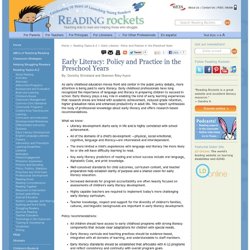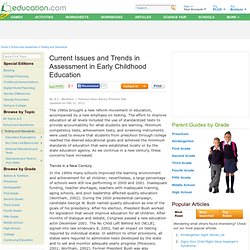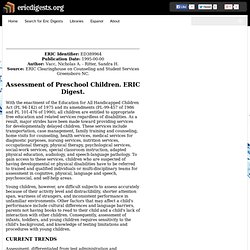

Citations page. Trends and Policy issues. Preschool. Early Literacy: Policy and Practice in the Preschool Years. By: Dorothy Strickland and Shannon Riley-Ayers As early childhood education moves front and center in the public policy debate, more attention is being paid to early literacy.

Early childhood professionals have long recognized the importance of language and literacy in preparing children to succeed in school. Early literacy plays a key role in enabling the kind of early learning experiences that research shows are linked with academic achievement, reduced grade retention, higher graduation rates and enhanced productivity in adult life. This report synthesizes the body of professional knowledge about early literacy and offers research-based recommendations. What we know: Literacy development starts early in life and is highly correlated with school achievement. Policy recommendations: All children should have access to early childhood programs with strong literacy components that include clear adaptations for children with special needs. Key predictive skills and abilities include: Article #6. Baltimore Jewish Times - the preeminent weekly Jewish publication - covers Jewish community information, opinion and news.
Article #5. Current Issues and Trends in Assessment in Early Childhood Education. The 1980s brought a new reform movement in education, accompanied by a new emphasis on testing.

The effort to improve education at all levels included the use of standardized tests to provide accountability for what students are learning. Minimum competency tests, achievement tests, and screening instruments were used to ensure that students from preschool through college reached the desired educational goals and achieved the minimum standards of education that were established locally or by the state education agency. As we continue in a new century, these concerns have increased. Trends in a New Century In the 1990s many schools improved the learning environment and achievement for all children; nevertheless, a large percentage of schools were still low performing in 2000 and 2001. In July 2001, the White House hosted the White House Summit on Early Childhood Cognitive Development. The No Child Left Behind Act of 2001 NCLB requires states to do the following: Article #2.
Assessment, Screening, and Reporting. Preschool. Assessments for Infants and Toddlers - FamilyConnect. Article #10. Assessment of Preschool Children. ERIC Identifier: ED389964 Publication Date: 1995-00-00 Author: Vacc, Nicholas A. - Ritter, Sandra H.

Source: ERIC Clearinghouse on Counseling and Student Services Greensboro NC. With the enactment of the Education for All Handicapped Children Act (PL 94-142) of 1975 and its amendments (PL-99-457 of 1986 and PL 101-476 of 1990), all children are entitled to appropriate free education and related services regardless of disabilities. As a result, major strides have been made toward providing services for developmentally delayed children.
These services include transportation, case management, family training and counseling, home visits for counseling, health services, medical services for diagnostic purposes, nursing services, nutrition services, occupational therapy, physical therapy, psychological services, social-work services, special classroom instruction, adapted physical education, audiology, and speech-language pathology. American Association for Higher Education (1992). Article #3. Developmental Screening: Preschool Screening Tests. Article #1.
Infant/Toddler Assessment: One Program's Experience. Article #4. Assessments for Young Children. By: ERIC Clearinghouse on Assessment and Evaluation (1999) What is assessment?

Assessment is the process of gathering information about a student in order to make decisions about his or her education. One kind of assessment procedure is testing. In elementary and secondary schools, tests are given routinely to measure the extent to which we profit from instruction. We may have taken intelligence, aptitude, interest, personality tests or any number of other kinds of tests. Formal vs. informal assessment Increasingly, educators are finding new ways to evaluate students' school performances using informal rather than formal, or standardized, assessment procedures.
Over the past few years, some districts have increased the use of curriculum-based measurements (CBM). The following are some examples of the two categories: Formal assessments: Norm-referenced tests have standardized, formal procedures for administering, timing and scoring. Criterion-referenced tests Informal/natural assessments: J. Article #9.